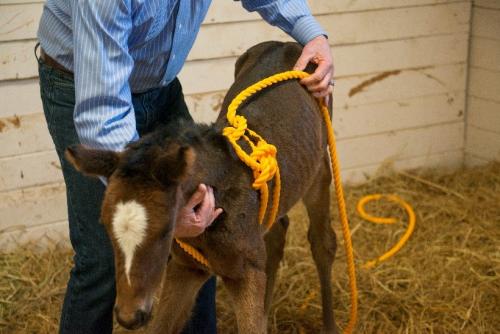
Neonatal Maladjustment Syndrome in Foals
What is neonatal maladjustment syndrome?
Takeaways
- Neonatal maladjustment syndrome (NMS) occurs in 1-2% of newborn foals.
- Affected foals, also known as “dummy foals”, exhibit neurological abnormalities and have recently been discovered to have abnormal hormone levels that affect behavior.
- The “Madigan Squeeze Technique” (MST) is an approach developed to create pressure that mimics the normal birth canal pressures which are believed to signal the foal to transition from sleeping in the womb to wakefulness. This is done by briefly applying pressure to the ribs using ropes looped around the ribcage for 20 minutes, which is the normal time period for birth transit through the birth canal.
- This discovery in foals is being applied in other animal species and has potential human infant connections to the swaddling method to improve infant health known as “kangaroo mother care”.
Foals that are affected with neonatal maladjustment syndrome (NMS), also known as “dummy foals”, appear healthy when they are born, but shortly thereafter exhibit neurological abnormalities. They are often detached, disoriented, unresponsive, confused, and have trouble nursing. This is in contrast to unaffected foals who are active one to two hours after birth, stay close to the mare and nurse within three hours (video). Affected foals can have metabolic problems, including failure of thermoregulation, gut motility, and reduced ventilation. Early work in England determined the disorder is associated with human interventions or rapid birth deliveries. The cause of the abnormal behavior was unknown but believed to be birth low oxygen levels affecting the brain. However, no expected long term brain injury is seen in 80% of the foals that recover with intensive care. The discovery of very high levels of neurosteroid hormones in the blood of affected foals and the ability to reproduce the syndrome experimentally by infusion of a neurosteroid led to new thinking about a way to reverse the syndrome by birth canal pressure signaling via the squeeze procedure.
Neonatal maladjustment syndrome affects 1-2% of foals. These foals are difficult to manage and may not survive without significant intervention. Early diagnosis and intensive treatment, including around-the-clock feedings, intravenous (IV) fluids, and plasma administration for up to ten days can be successful, but is expensive and time-consuming.
Other causes that lead to weak newborn foals should be ruled out. It may be necessary to consult with a veterinarian to determine the cause and most appropriate treatment for a weak foal.
What is the “Madigan Squeeze Technique”?
The “Madigan Squeeze Technique” (MST), or “Madigan thoracic squeeze”, is an approach developed by UC Davis veterinarian and equine neonatal expert Dr. John Madigan to treat “dummy foals”. Madigan postulates that the journey through the birth canal activates a biochemical switch that enables newborns to transition from a calm, sedative state in the womb to alert consciousness - an essential early life step for prey species whose survival depends on being alert and mobile shortly after birth. In cases where this physical transition does not occur, the newborn remains in the quiet state they experienced in the womb. The MST acts to simulate the physical pressure of the birth canal and “activate the switch” to an alert state. Experimental studies at the UC Davis Center for Equine Health using the squeeze technic in normal foals revealed significant brain wave changes during the squeeze procedure and alterations in hormone levels.
This procedure should only be performed by skilled handlers after the newborn has been determined to not be experiencing respiratory issues, neuromuscular disease (such as botulism), or broken ribs.
Videos of Dr. Madigan performing the procedure are available here and and here.
- Tie a bowline knot and make a fixed loop so that the rope will slide through like a honda on a lariat.
Starting at the foal’s withers, place the rope across the neck and between the front legs. Bring the end of the rope back up to withers.

Thread the end of the rope through the fixed loop and adjust to a snug fit so there is pressure on the chest but no airway obstruction.

Pass the rope over the foal and make a half-hitch. Snug the rope just behind the elbow where a cinch would go on a saddle.

Pass the rope over the foal’s ribcage again about 6 inches back from the first half hitch and snug it up.


Have the assistant hold the foal. Position yourself behind the foal and apply a steady pressure by pulling on the rope. Gradually increase the pressure until the foal begins to lay down.

Keep the same pressure (about 10-20 lbs) on the foal when it lies down and maintain it for the 20-minute duration of the squeeze. Allow the mare to stand close enough to view the foal. The mare usually seems to know that the foal is asleep and stands watch. Protect yourself from the foal kicking or moving its head during this time. Some foals move once or twice during the 20 minutes of squeeze.

- At the end of the 20-minute squeeze, release pressure on the rope and allow the foal to stay down or get up as it chooses. Slowly move the rope away from the foal. Do not force the foal to get up. Let the foal sleep more if it wants. When the foal gets up, mimic normal mare behavior and pinch it on the rump or back to provide tactile stimulation. Allow the foal to do whatever it wants and observe. Do not attempt to assist nursing or push to the mare.
What is the prognosis for foals affected with neonatal maladjustment syndrome?
A survey of veterinarians that utilized the MST found that NMS foals that were squeezed (with or without medical therapy) were 3.7 times more likely to recover quickly than foals that were not squeezed. Squeezed foals were also reported to be 15 times more likely to recover in less than an hour. Foals that received only squeezing, and no medical intervention, were 17.5 times more likely to recover in the first 24 hours than foals that were treated solely with medication. No side effects were indicated. The study reported that 12% of all foals and 14% of squeezed foals did not recover. In foals sent to referral clinics with a diagnosis of maladjustment, the survival rate in several studies is reported to be 80%.
For more information
Publications:
Toth, B., Aleman, M., Brosnan, R.J., Dickinson, P.J., Conley, A.J., Stanley, S.D., Nogradi, N., Williams, C.D., Madigan, J.E. 2012. Evaluation of squeeze-induced somnolence in neonatal foals. American Journal of Veterinary Research 73 (12), 1881-1889,.
Aleman, M., Pickles, K.J., Conley, A.J., Stanley, S., Haggett, E., Toth, B., Madigan, J.E. 2013. Abnormal plasma neuroactive progestagen derivatives in ill, neonatal foals presented to the neonatal intensive care unit. Equine Veterinary Journal 45, 3-3.
Estell, K., Aleman, M., Williams, C.D., Pickles, K.J., Riley, R., Madigan, J.E. 2013. Clinical Signs, Neurobehavioral Score, And Electroencephalogram Recordings Associated With Infusion of a Pregnenolone Derivative to Induce Neonatal Maladjustment Syndrome. Journal of Veterinary Internal Medicine 27 (3), 663-664.
Madigan, J.E., Haggett, E.F., Pickles, K.J., Conley, A., Stanley, S., Moeller, B., Toth, B., Aleman, M. 2012. Allopregnanolone infusion induced neurobehavioural alterations in a neonatal foal: is this a clue to the pathogenesis of neonatal maladjustment syndrome? Equine Veterinary Journal 44, 109-112.
Aleman, M., McCue, P.M., Chigerwe, M., Madigan, J.E. 2019. Plasma concentrations of steroid precursors, steroids, neuroactive steroids, and neurosteroids in healthy neonatal foals from birth to 7 days of age. Journal of Veterinary Internal Medicine 33 (5), 2286-2293.
McCallie, K.R., Gaikwad, N.W., Castillo Cuadrado, M.E., Aleman, M., Madigan, J.E., Stevenson, D.K., Bhutani, V.K. 2017. Skin-to-skin contact after birth and the natural course of neurosteroid levels in healthy term newborns. Journal of Perinatology 37 (5), 591-595.
Aleman, M., Weich, K.M., Madigan, J.E. 2017. Survey of veterinarians using a novel physical compression squeeze procedure in the management of neonatal maladjustment syndrome in foals. Animals 7 (9), 69.
Pickles, K.J., Madigan, J.E., Torske, S., Aleman, M.R. 2014. Use of Squeeze‐Induced Somnolence for Routine Plasma Administration in Healthy Neonatal Foals. Equine Veterinary Journal 46, 4-4.
More information
Foal Squeezing with 'Madigan Squeeze', The Manual of Equine Neonatal Medicine
“Vets Learn ‘Madigan Foal Squeeze Technique’”, The Equine Chronicle (December 2018)
“Newborn Horses Give Clues to Autism”, UC Davis (February 2015)
Equine Neonatal Maladjustment, Equine and Comparative Neurology Group, UC Davis School of Veterinary Medicine
*This article may not be reproduced without the written consent of the UC Davis Center for Equine Health. Please email requests to cehadmin@ucdavis.edu.
